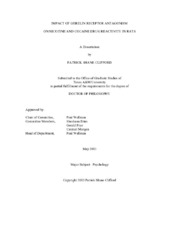| dc.description.abstract | Ghrelin is a 28 amino acid peptide that interacts with ghrelin receptors (GHS-Rs) to modulate brain reinforcement circuits. Systemic ghrelin infusions augment cocaine (COC) stimulated locomotion and conditioned place preference (CPP) in rats, whereas genetic or pharmacological ablation of GHS-Rs has been shown to attenuate the acute locomotor-enhancing effects of nicotine (NIC) and COC, and to blunt the CPP induced by food, alcohol, amphetamine and COC in mice. The stimulant NIC can induce CPP and like COC, repeated administration of NIC induces locomotor sensitization in rats. In experiment 1, we examined the effects of GHS-R antagonism with JMV 2959 on COC-induced locomotion and found that JMV 2959 suppresses COC-induced locomotor sensitization. In experiment 2, we examined the effects of GHS-R antagonism with JMV 2959 on NIC-induced locomotion and found that JMV 2959 suppresses NIC-induced locomotor sensitization. In experiment 3, we examined the effects of GHS-R knockout on COC-induced locomotion and found that animals sustaining GHS-R knockout display a suppression of COC-induced locomotor sensitization. In experiment 4, we examined the effects of GHS-R knockout on COC-induced locomotion and found that animals sustaining GHS-R knockout display a suppression of COC-induced locomotor sensitization. In experiment 5, we examined the effects of JMV 2959 on NIC-enhanced intracranial self-stimulation (ICSS) responding and found that JMV 2959 alone had no effect, but when combined with NIC,JMV 2959 pretreatment reversed the enhancement of responding produced by NIC. In experiment 6, we examined the effects of GHS-R knockout on ICSS responding and found that animals sustaining GHS-R knockout were unable to acquire ICSS at current intensity levels that would support responding by WT animals. It was not until the intensity was ramped up four fold that these knockout rats were able to acquire responding. These results show that antagonism of GHS-Rs diminishes the reinforcing effects of NIC and COC. This provides evidence that antagonists of GHS-Rs could be useful in the treatment of drug addiction, particularly that involving nicotine. | en |


